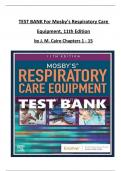TEST BANK For Mosby’s Respiratory Care
Equipment, 11th Edition
by J. M. Cairo Chapters 1 - 15
,Description
The most clinically relevant respiratory care equipment textbook on the market, Mosby’s Respiratory
CareEquipment, 10th Edition employs a "how-to" approach that moves beyond technical descriptions of
machinery. Learn to identify equipment, understand how it works, and apply your knowledge to clinical
practice with this comprehensive overview of the equipment and techniques used by respiratory
therapists to treat cardiopulmonary dysfunction. The 10th edition includes updated information on the
latest devices and equipment, which are divided into clearly defined sections including: ventilators,
transport, home-care, neonatal and pediatric ventilators, and alternative ventilators. In addition, there’s
a focus on specific ventilator characteristics such as mode, monitors and displays, alarms and indicators,
graphics, special features, and troubleshooting for lesser-used ventilators.
Table of Contents
I. Introduction
1. Basic Physics for the Respiratory Therapist
2. Principles of Infection Control
3. Introduction to Ventilators
II. Medical Gases
4. Manufacture, Storage, and Transport of Medical Gases
5. Administering Medical Gases: Regulators, Flowmeters, and Controlling Devices
6. Humidity and Aerosol Therapy
,III. Assessment
7. Assessment of Pulmonary Function
8. Assessment of Cardiovascular Function
9. Blood Gas Monitoring
IV. Devices
10. Lung Expansion Devices
11. Mechanical Ventilators: General-Use Devices
12. Infant/Pediatric Ventilators
13. Home-Care, Transport Devices, Alternative Devices
V. Critical Care and Other Therapies
14. Airway Management Devices and ACLS
15. Sleep Diagnostics
,Chapter 01: Basic Physics for the Respiratory Therapist
MULTIPLE CHOICE
1. Power is a measure of which of the following?
a. Mechanical energy
b. Gravitational potential energy
c. The rate at which work is being performed
d. The rate at which atoms and molecules move
ANSWER: C
Power is a measure of the rate at which work is being performed. The formula P = W/J, where
W = watts and 1 watt is equal to 1 J/s, expresses this. Joules are the international standard for
expressing energy and work.
PTS: 1 REF: Page 8
2. When effort produces a change in the position of matter:
a. work is performed.
b. it is known as a joule.
c. mechanical power is created.
d. the law of the conservation of energy is being used.
ANSWER: A
Work is performed only when effort or outside forces produce a change in the position of
matter.
PTS: 1 REF: Page 8
3. The unit used to express the force of 1 newton (N) acting on a 1-kilogram (kg) object to
moveit 1 meter (m) is which of the following?
a. Watt c. Kilowatt
b. Joule d. Kinetic energy
ANSWER: B
, One joule is equal to the force of 1 N acting on 1 kg. A watt is equivalent to 1 J/s. A kilowatt is
simply 1000 W. Kinetic energy is energy an object possesses when it is in motion.
PTS: 1 REF: Page 8
4. Power is expressed in which of the following units?
a. Newtons c. Ohms
b. Joules d. Watts
ANSWER: D
Power is a measure of the rate at which work is being performed. Energy and work are
measured in joules. One joule is the force of 1 N acting on a 1-kg object to move it 1 m. Ohms
is the resistance an electrical circuit possesses.
PTS: 1 REF: Page 8
,5. Four horsepower (hp) is equal to how many kilowatts (kW)?
a. 5.36 c. 2984
b. 2.98 d. 186.5
ANSWER: B
1 hp = 0.746 kW.
1 hp/0.746 = 4 hp/X.
X = 4 0.476 = 2.98 kW.
PTS: 1 REF: Page 8
6. The energy that an object possesses when it is in motion is called:
a. sound. c. thermal.
b. kinetic. d. potential.
ANSWER: B
Kinetic energy is the energy an object possesses when it stays in motion. Potential energy is
stored energy, and it exists in many forms such as thermal energy or sound waves.
PTS: 1 REF: Page 9
7. If the velocity of an object is reduced by half, its kinetic energy will be which of the
following?
a. Reduced to one eighth c. Reduced twofold
b. Increased twofold d. Not changed
ANSWER: A
Kinetic energy = (mass of object square of velocity it is traveling, or mv2) or KE = (V
V). If the velocity is reduced by half, then KE = ( V V), or ( )= reduction.
PTS: 1 REF: Page 10
8. Energy that is stored in an object is called which of the following?
a. Kinetic c. Chemical
b. Potential d. Mechanical
ANSWER: B
, Energy that is stored or possessed by an object because of its position is called potential
energy. Mechanical energy can be divided into either kinetic energy or potential energy.
Chemical potential energy often refers to the bonds in petroleum oils that, if broken, can be
converted to kinetic energy.
PTS: 1 REF: Page 10
9. The potential energy of a compressed spring is known as which of the following?
a. Gravitational c. Inelastic
b. Chemical d. Elastic
ANSWER: D
, The potential energy stored in a compressed spring is called elastic potential energy. This
energy is released when the spring is allowed to uncoil. Gravitational potential energy is the
energy an object possesses if it is held above any surface, energy that the object’s weight
gainsas it falls. Chemical potential energy resides in the chemical bonds of the atoms that
make up the object. Inelastic potential energy would not apply once the spring is
compressed.
PTS: 1 REF: Page 10
10. The energy stored in heating oil is known as which of the following?
a. Elastic c. Chemical
b. Atomic d. Gravitational
ANSWER: C
Petroleum reserves of coal, oil, and gas represent chemical potential energy by virtue of the
chemical bond that must be broken to release energy. Heating oil potential energy has
chemical-to-chemical bonds. Atomic energy involves two processes—fission (splitting atoms)
and fusion (joining two atoms).
PTS: 1 REF: Page 8
11. The kinetic theory holds that:
a. all matter is composed of tiny particles.
b. elements combine in fixed proportions to form molecules.
c. the energy that an object gains as it falls is a result of gravity.
d. atoms and molecules that make up matter are in constant motion.
ANSWER: D
Kinetic energy is the energy an object possesses while in motion.
PTS: 1 REF: Page 9
12. Which is the correct order for increasing size?
a. Atoms, molecules, mixtures, compounds, elements
b. Atoms, elements, molecules, compounds, mixtures
c. Elements, atoms, molecules, compounds, mixtures
, d. Atoms, elements, mixtures, molecules, compounds
ANSWER: B
All matter, whether in gas, liquid, or solid form, is made up of atoms that can combine to form
elements; the elements can then combine to form molecules. Molecules can combine to form
compounds. Combining compounds makes a mixture.
PTS: 1 REF: Page 10
13. Atoms and molecules arranged in an orderly fashion are called:
a. Solids c. Crystalline
b. Mixtures d. Amorphous
ANSWER: C
Crystalline solids are highly organized structures whose atoms and molecules are arranged
ina lattice configuration. Amorphous solids have atoms and molecules that are less rigidly
arranged.
, PTS: 1 REF: Page 10
14. The most potential energy is contained by which state of matter?
a. Gases c. Liquids
b. Solids d. Mixtures
ANSWER: B
Of all states of matter, solids contain the most potential energy; solids are followed by liquids
and then gases.
PTS: 1 REF: Page 11
15. Which of the following are amorphous solids?
1. Iron
2. Glass
3. Plastic
4. Margarine
a. 1 c. 2 and 4
b. 1 and 3 d. 2, 3, and 4
ANSWER: D
Glass and margarine are always considered amorphous solids. Plastic usually shows
flexibility, which implies that it has amorphous features, so it should be considered
amorphous. Iron, however, has well-organized atoms in a crystalline arrangement.
PTS: 1 REF: Page 10
16. Supercooled liquids are also known as which of the following?
a. Elements c. Crystalline solids
b. Compounds d. Amorphous solids
ANSWER: D
Amorphous solids are sometimes called supercooled liquids. Elements and compounds alone
can combine to form either crystalline or amorphous solids.
PTS: 1 REF: Page 10





